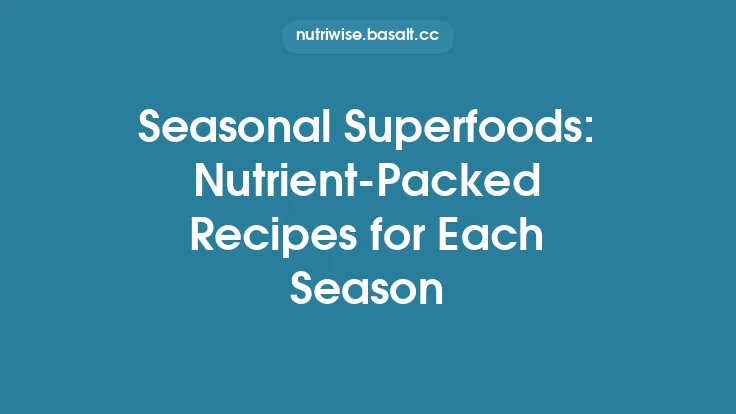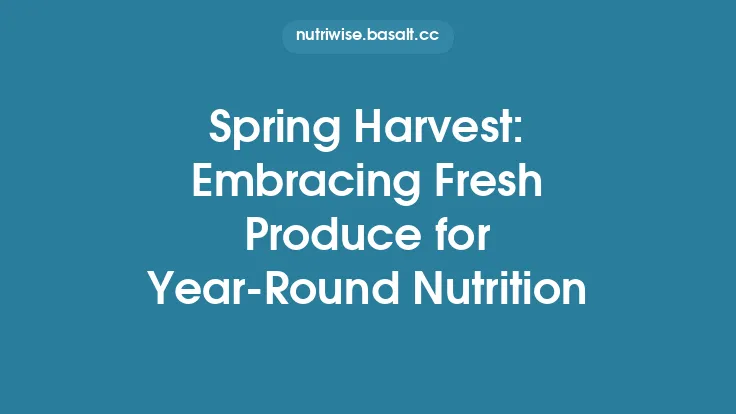Spring is a time of renewal, and the foods that burst onto the market during this season are uniquely equipped to support the body’s own cycles of rejuvenation. As the days lengthen and temperatures rise, a fresh palette of vegetables, fruits, herbs, and sprouts becomes available, each bringing a distinct blend of vitamins, minerals, phytonutrients, and bioactive compounds. Understanding why these foods are especially potent in spring, how their nutrient profiles align with the physiological demands of the season, and the best ways to incorporate them into everyday meals can empower anyone looking to harness nature’s seasonal bounty for optimal health.
What Makes a Food a Spring Superfood?
A “superfood” label is often applied loosely, but from a scientific standpoint a superfood is any whole food that delivers a high concentration of nutrients relative to its caloric content, and that contains bioactive compounds with demonstrable health benefits. Spring superfoods meet additional criteria:
- Seasonal Peak – They are harvested at the height of their natural growth cycle, when nutrient density is maximized. Post‑harvest storage and transport can degrade vitamins and phytochemicals; spring produce, consumed shortly after picking, retains more of its original potency.
- Phyto‑Chemical Richness – Many spring foods are rich in glucosinolates, flavonoids, and polyphenols that have been linked to detoxification pathways, anti‑inflammatory signaling, and cellular protection.
- Synergistic Nutrient Profiles – The combination of macro‑ and micronutrients in spring foods often supports enhanced absorption of each other (e.g., vitamin C improving iron uptake from leafy greens).
- Adaptation to Seasonal Physiology – As the body transitions from a lower‑light, lower‑temperature winter state to a more active spring state, it requires nutrients that support mitochondrial biogenesis, collagen synthesis, and immune modulation—processes that spring superfoods are uniquely positioned to aid.
Key Nutrients in Spring Produce
| Nutrient | Primary Spring Sources | Functional Role |
|---|---|---|
| Vitamin C (ascorbic acid) | Asparagus, strawberries, rhubarb, kiwi | Antioxidant, collagen synthesis, enhances non‑heme iron absorption |
| Folate (vitamin B9) | Spinach, kale, beet greens, peas | DNA synthesis, methylation, supports rapid cell turnover |
| Vitamin K1 (phylloquinone) | Swiss chard, collard greens, mustard greens | Coagulation cascade, bone mineralization |
| Beta‑carotene & other provitamin A carotenoids | Carrots, pumpkin, orange-fleshed sweet potatoes (early varieties) | Vision, immune function, skin health |
| Magnesium | Swiss chard, pumpkin seeds, almonds (early harvest) | Enzyme cofactor, ATP production, neuromuscular function |
| Potassium | Avocado (early season), tomatoes, peas | Fluid balance, nerve transmission, blood pressure regulation |
| Glucosinolates | Broccoli, Brussels sprouts, radishes, mustard greens | Precursors to isothiocyanates, which activate phase II detox enzymes |
| Polyphenols (e.g., quercetin, catechins) | Strawberries, cherries, green tea (early harvest) | Modulate inflammatory pathways, support endothelial function |
| Omega‑3 fatty acids (ALA) | Chia seeds, early spring walnuts | Anti‑inflammatory, membrane fluidity, neuroprotection |
These nutrients do not act in isolation. For instance, the high vitamin C content in strawberries dramatically improves the bioavailability of the non‑heme iron found in spinach, while the magnesium in Swiss chard supports the enzymatic conversion of vitamin D to its active form, amplifying calcium utilization for bone health.
Top Spring Superfoods and Their Profiles
1. Asparagus (Asparagus officinalis)
- Nutrient Highlights: 20 % DV of vitamin K, 15 % DV of folate, 10 % DV of vitamin C per 100 g.
- Bioactive Compounds: Saponins and asparagine, a non‑essential amino acid that serves as a nitrogen carrier in the urea cycle.
- Health Implications: Supports liver detoxification via upregulation of glutathione‑S‑transferase; may improve renal function by promoting diuresis without excessive electrolyte loss.
2. Rhubarb (Rheum rhabarbarum)
- Nutrient Highlights: 30 % DV of calcium, 12 % DV of potassium, modest vitamin K.
- Bioactive Compounds: Anthraquinone glycosides (e.g., emodin) with mild laxative activity, and polyphenols that inhibit α‑glucosidase, moderating post‑prandial glucose spikes.
- Health Implications: Useful for gentle bowel regulation and supporting bone mineral density when paired with vitamin D‑rich foods.
3. Wild Greens (e.g., Dandelion, Lamb’s Quarters)
- Nutrient Highlights: Up to 200 % DV of vitamin A (beta‑carotene) and 150 % DV of vitamin K per cup.
- Bioactive Compounds: Taraxasterol (in dandelion) stimulates bile flow, aiding lipid digestion; flavonoids that modulate NF‑κB signaling.
- Health Implications: Promote hepatic bile production, improve lipid metabolism, and provide anti‑inflammatory support.
4. Strawberries (Fragaria × ananassa)
- Nutrient Highlights: 150 % DV of vitamin C, 10 % DV of manganese, 5 % DV of folate per cup.
- Bioactive Compounds: Ellagic acid and anthocyanins that protect endothelial cells from oxidative stress.
- Health Implications: May reduce LDL oxidation, supporting cardiovascular health; also contributes to skin collagen maintenance.
5. Peas (Pisum sativum)
- Nutrient Highlights: 25 % DV of protein, 15 % DV of fiber, 20 % DV of vitamin K.
- Bioactive Compounds: Pea protein isolates contain high levels of lysine, an essential amino acid often limiting in plant diets.
- Health Implications: Provide a plant‑based protein source that supports muscle repair during the increased physical activity typical of spring.
6. Radishes (Raphanus sativus)
- Nutrient Highlights: 30 % DV of vitamin C, 10 % DV of potassium per 100 g.
- Bioactive Compounds: Glucosinolates that convert to sulforaphane upon chewing, a potent inducer of the Nrf2 pathway.
- Health Implications: Enhances cellular antioxidant defenses and may support detoxification of environmental pollutants.
7. Early‑Season Berries (e.g., Gooseberries, Serviceberries)
- Nutrient Highlights: High in vitamin C and vitamin A precursors, moderate fiber.
- Bioactive Compounds: Unique flavonol glycosides that have been shown in vitro to inhibit platelet aggregation.
- Health Implications: Potentially beneficial for maintaining healthy blood flow during the transition to more active outdoor pursuits.
Culinary Techniques to Preserve Nutrients
The method of preparation can dramatically influence the retention of vitamins, minerals, and phytonutrients. Below are evidence‑based strategies tailored to spring superfoods:
| Technique | Rationale | Best‑Fit Foods |
|---|---|---|
| Steaming (2–4 min) | Minimal water contact reduces leaching of water‑soluble vitamins (C, B‑complex) while softening cell walls for better digestibility. | Asparagus, broccoli, Swiss chard |
| Quick‑Sauté (high heat, <2 min) | Brief exposure to heat preserves heat‑labile compounds while allowing Maillard reactions that enhance flavor and increase bioavailability of certain antioxidants. | Peas, kale, mustard greens |
| Raw Consumption | Maximizes vitamin C and folate content; preserves enzyme activity (e.g., myrosinase in cruciferous vegetables, which converts glucosinolates to isothiocyanates). | Radishes, wild greens, strawberries |
| Fermentation (lacto‑fermented) | Converts glucosinolates into more bioavailable isothiocyanates; introduces probiotic bacteria that improve gut barrier function. | Sauerkraut from early cabbage, kimchi with radish |
| Blanching followed by Shock‑Cooling | Deactivates oxidative enzymes (polyphenol oxidase) that can degrade color and antioxidants, while preserving texture for salads. | Asparagus tips, green beans |
| Low‑Temperature Roasting (120‑130 °C, 30 min) | Slow heat allows for caramelization of sugars without excessive vitamin loss; enhances beta‑carotene bioavailability via gentle cell‑wall breakdown. | Early carrots, pumpkin slices |
| Infusion (cold‑brew or hot‑steep) | Extracts water‑soluble polyphenols without degrading them; ideal for making nutrient‑rich beverages. | Strawberry‑mint water, rhubarb tea |
A practical tip: combine raw and lightly cooked preparations in the same meal. For example, a salad of raw radish slices paired with lightly steamed asparagus ensures you capture both the heat‑sensitive vitamin C and the heat‑activated sulforaphane from cruciferous greens.
Integrating Spring Superfoods into Daily Meals
Breakfast
- Berry‑Almond Overnight Oats: Mix rolled oats with almond milk, a handful of chopped strawberries, a spoonful of chia seeds, and a drizzle of honey. The overnight soak preserves vitamin C and provides a steady release of ALA omega‑3s.
- Green Smoothie with Wild Greens: Blend a cup of dandelion greens, half a banana, a quarter cup of frozen early‑season berries, and a scoop of pea‑protein powder. The raw greens retain folate, while the banana supplies potassium for electrolyte balance.
Lunch
- Asparagus & Pea Risotto (lightly sautéed): Use a short‑grain rice, add a splash of white wine, then stir in blanched asparagus tips and peas at the final stage. Finish with a sprinkle of grated Parmesan for calcium and a squeeze of lemon for extra vitamin C.
- Radish & Avocado Wrap: Thinly slice radishes and combine with mashed avocado, lime juice, and cilantro. Wrap in a whole‑grain tortilla for a fiber‑rich, nutrient‑dense lunch.
Snack
- Rhubarb Compote with Greek Yogurt: Simmer chopped rhubarb with a touch of maple syrup until tender. Cool and serve over plain Greek yogurt for a probiotic boost and calcium.
- Steamed Swiss Chard Chips: Lightly steam chard leaves, pat dry, toss with olive oil and sea salt, then bake at 150 °C for 10 min until crisp.
Dinner
- Spring Vegetable Stir‑Fry: Combine broccoli florets, snap peas, and sliced early carrots in a wok with ginger, garlic, and a low‑sodium soy‑ginger glaze. Serve over quinoa for a complete amino‑acid profile.
- Grilled Salmon with Strawberry‑Basil Salsa: While salmon provides EPA/DHA, the salsa adds vitamin C, anthocyanins, and the herbaceous aroma of basil, creating a synergistic anti‑inflammatory meal.
Dessert
- Strawberry‑Rhubarb Crumble: Use a modest amount of whole‑grain oat topping, a small amount of butter, and a mixture of strawberries and rhubarb. The crumble’s modest sugar content allows the natural flavors and nutrients to shine.
Seasonal Bioavailability and Timing
Nutrient absorption is not static; it fluctuates with circadian rhythms, hormonal cycles, and the presence of complementary foods. A few timing considerations for spring superfoods:
- Morning Vitamin C Surge: Consuming vitamin‑C‑rich foods (strawberries, rhubarb) early in the day can enhance iron absorption from breakfast cereals or leafy greens, aligning with the body’s higher daytime metabolic rate.
- Mid‑Afternoon Folate Boost: Folate is essential for DNA repair and methylation, processes that peak during the afternoon when cellular turnover accelerates. Pairing folate‑dense greens with a small amount of healthy fat (e.g., avocado) improves its uptake.
- Evening Magnesium for Sleep: Magnesium‑rich Swiss chard or pumpkin seeds consumed 30–60 minutes before bedtime support GABAergic activity, promoting relaxation and deeper sleep—a crucial component of spring recovery after increased physical activity.
- Post‑Exercise Protein Synthesis: Pea protein or other plant‑based proteins from early peas are ideal within the 30‑minute window after moderate aerobic or strength training, providing essential amino acids for muscle repair.
- Seasonal Hormonal Support: The rise in natural light during spring stimulates melatonin suppression and cortisol regulation. Foods high in vitamin K (mustard greens) and B‑vitamins (whole‑grain oats) can help modulate these hormonal shifts, reducing stress‑related inflammation.
Potential Interactions and Considerations
While spring superfoods are generally safe, certain individuals should be mindful of specific interactions:
- Warfarin Users: High vitamin K intake (e.g., from kale, Swiss chard) can antagonize anticoagulant therapy. Consistency in intake rather than avoidance is key; patients should discuss dietary patterns with their healthcare provider.
- Thyroid Function: Cruciferous vegetables contain goitrogens that may interfere with iodine uptake when consumed in extremely large quantities raw. Cooking (steaming) reduces goitrogenic activity, making them safe for most individuals.
- Kidney Stones: Oxalate‑rich foods like spinach can contribute to calcium oxalate stone formation in susceptible individuals. Pairing with calcium‑rich foods during the same meal can mitigate absorption.
- Allergies: Early‑season berries may trigger oral allergy syndrome in people with pollen allergies. Cooking or processing the fruit can reduce allergenic proteins.
- Medication Metabolism: Certain polyphenols (e.g., quercetin in strawberries) can inhibit CYP3A4 enzymes, potentially affecting the metabolism of drugs such as certain statins or antihistamines. Consultation with a pharmacist is advisable for those on chronic medication.
Future Trends and Research in Spring Nutrition
The scientific community continues to explore how seasonal eating patterns influence long‑term health outcomes. Emerging areas of interest include:
- Chrononutrition: Investigating how aligning food intake with circadian biology can optimize metabolic health. Early‑season foods rich in specific micronutrients may act as zeitgebers (time‑givers) for peripheral clocks.
- Microbiome‑Seasonality: Preliminary studies suggest that the gut microbiota composition shifts with seasonal dietary changes, influencing short‑chain fatty acid production and immune modulation. Spring‑rich prebiotic fibers from peas and radishes are under investigation for their role in fostering beneficial bacterial taxa.
- Epigenetic Modulation: Glucosinolates and folate from spring greens have been shown in animal models to affect DNA methylation patterns, potentially influencing gene expression related to inflammation and aging.
- Sustainable Harvest Techniques: While not the focus of this article, advances in controlled‑environment agriculture (e.g., vertical farms) aim to deliver peak‑nutrient spring produce year‑round, raising questions about the interplay between “seasonal” and “nutrient‑dense” in future dietary guidelines.
By embracing the unique nutrient profile of spring’s bounty—rich in vitamin C, folate, vitamin K, glucosinolates, and a spectrum of phytonutrients—individuals can support the body’s natural renewal processes, enhance metabolic efficiency, and lay a solid foundation for health throughout the year. Thoughtful preparation, strategic timing, and awareness of personal health considerations ensure that these seasonal superfoods deliver their maximum benefit, turning the simple act of eating into a powerful tool for seasonal rejuvenation.





